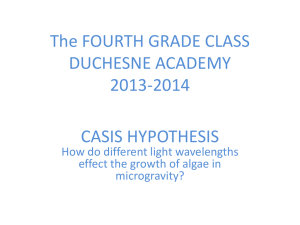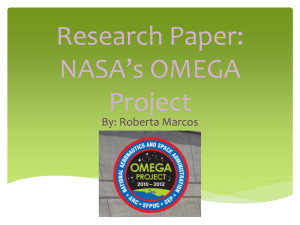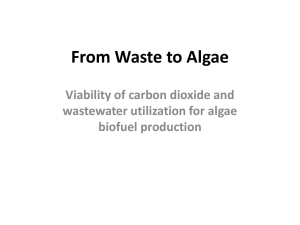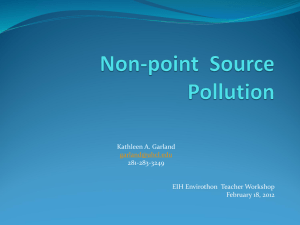View Powerpoint Presentation
advertisement
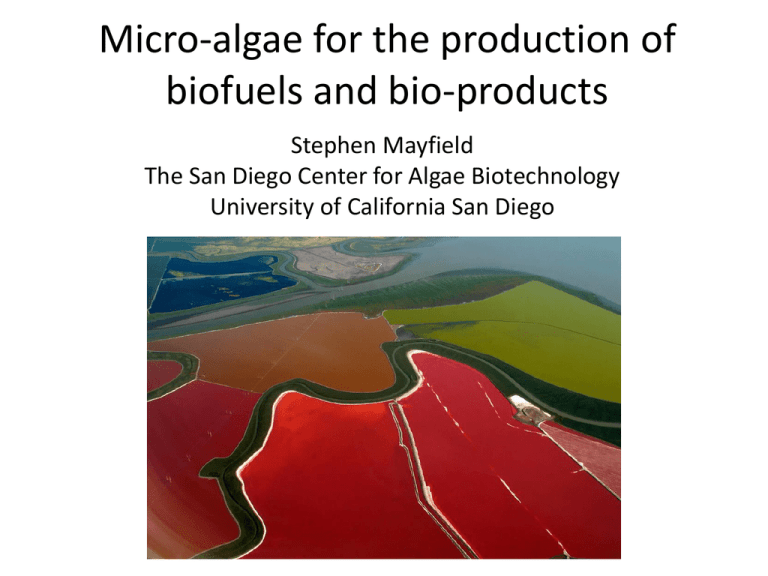
Micro-algae for the production of biofuels and bio-products Stephen Mayfield The San Diego Center for Algae Biotechnology University of California San Diego Algae: Latin “Seaweed” • Any of a the group of aquatic eukaryotic organisms that carry on photosynthesis – Range from microscopic single cells to very large multicellular organism such as kelp – Further categorized as brown algae, red algae, green algae, and dinoflagellates • Photosynthetic aquatic prokaryotes are known as cyanobacteria or blue-green algae - and are also used for biofuels production BioFuels are the Biological conversion of sunlight energy into chemical energy Carbohydrate Protein Hydrocarbons Petroleum (algae) and Coal (plants) are simply fossil Biofuels BioFuels are already a significant business in the world Food Fermentation Into Fuel Photosynthesis In crops Photosynthesis In Algae Fiber Burn for Electricity Natural Oils Liquid Fuels Why does energy matter so much? And why is petroleum so important Without oil Without coal Without nuclear Source: 2006 Key world energy statistics, IEA Utilization of the World’s Energy Supplies 3.0 Billion 300 Million The American Dream has become the World’s Dream Beijing Freeway 2009 - 19 Million New Cars in China in 2010 Energy consumption was up 11% in China last year When Will the World’s Oil Run Out? You are Here! Data compiled from: EIA, BP statistical review of world energy, & nashawi et al 2010. Thousands of barrels/day Oil Production Over the Last 10,000 Years www.eia.doe.gov Time (years) The End of the Hydrocarbon Era Total World Energy P1 Reserves* Coal Oil Natural Gas Nuclear Total Reserves 1013 TW-yr 582 TW-yr 539 TW-yr 60-300 TW-yr ~2194-2434 TW-yr Assuming continued 2 % growth in consumption* We will run out of all energy reserves ~2099 If world was at US consumption rates now: we would run out in 2048 * International Energy Agency, World Energy Outlook 2001:Assessing Today‘s Supplies to Fuel Tomorrow‘s Growth Energy Return On Investment The EROI for the Alberta Tar Sands is 5:1, Saudi Arabia it is 100:1 Canadian Tar Sands Oil are Now the #1 Oil Import into the US Climate Change and the Impact of Carbon Dioxide www.scientific american.com Anthropogenic Greenhouse Effect Anthropogenic – human activity that has an affect on the environment Carbon Dioxide Transportation, heating and cooling, manufacturing, deforestation Nitrous oxide Fertilizers, fossil fuels, soils and oceans Methane Agriculture, natural gas, landfills, wetlands Halocarbons Refrigeration Water Vapor Most abundant greenhouse gas, but not largely affected by human impact IPCC Synthesis Report 2007 Measuring Carbon Dioxide in the Atmosphere Charles D. Keeling (1928-2005) Mauna Loa Observatory, Hawaii Scripps Institution of Oceanography Hasn’t this happened in the past? Yes – but the time frame has been much longer The rate of CO2 change now is happening in a short period Look at us now! Highest level of CO2in recent past Ice Ages occur when carbon dioxide and temperatures drop Currently in a naturally warmer interglacial period, but it is coming to an end What will happen due to the higher levels of carbon dioxide? UNEP http://maps.grida.no/go/graphic/historical-trends-in-carbon-dioxide-concentrations-and-temperature-on-a-geological-and-recent-time-scale Consequences of Sea Level Rise in Gulf of Mexico Why such a Disconnect? • Enormous social-economic consequences of changing • Scientists rarely communicate well • Society has a science illiteracy problem • A disinformation campaign is effective • In some countries, this topic is politicized • Media coverage of science is often poor U.S. sets the example but now it’s out of our hands % Change in CO2 emissions Rate of Change in CO2 Emissions between 1971 and 2008 800 700 600 500 400 300 200 100 0 U.S. India China IEA Statistics 2010 – Global CO2 Emissions Worldcommunitycookbook.org Food and Fuel Prices are now linked Oil Price per Barrel Price per Bushel Maize Solarnavigator.net Jan 1980 – Jan 2011 U.S. Number 2 yellow, fob Gulf of Mexico Jan 1980 – Jan 2011 Average of U.K. Brent, Dubai, and West Texas Intermediate Price per Bushel Grain Prices also closely track one another Year The Green Revolution The introduction of modern farming techniques and higher-yielding pest-resistant varieties of crops to significantly increase crop production Started in 1943 in Mexico by Norman Borlaug For which he won the Nobel Peace Prize in 1970 Millions of people World Population and Fossil Fuel Utilization Are Linked Time (years) Impact of the Green Revolution on Food Production and Cost Production Increased and Cost Decreased for Major Food Crops Khush, G.S. (2001) Nature Reviews Genetics. 2: 815-822 How will we replace this energy source? *Energy can neither be created nor destroyed, it can only be transformed from one state to another Photosynthesis is the conversion of solar energy into chemical energy *First law of thermodynamics The World Consumes 15 Terawatts of Energy every Year - 85% Fossil Fuel The Good News The Sun Provide 86,000 Terawatts of Energy Every Year Why algae as a conversion platform Scalability Productivity Sustainability Fungible Fuels We burn 300 Billion gallons of petroleum a year Efficient Growth and Oil production Oil content (%) Oil Yield gal/acre Canola 40-45 113 Mustard 25-27 70 Safflower 42-48 146 Soy 20-22 55 Jatropha 32-35 202 Palm 48-52 635 Algae 20-60 ~ 5,000 Crop Growth Efficiency (MT/acre/yr) 50 40 30 20 10 0 algae switchgrass sugarcane corn 5,000 gal/acre X 60 million acres = 300 billion gal Processing Algae to Green Crude Grow Harvest Extract Concentrate Once the oils are processed to green crude they can go directly into existing oil refineries Fungible fuels have been made from algae oil Algaeus, hybrid vehicle crossed the country on algae-based renewable gasoline or diesel 2009 - Sapphire Many air flights using algae jetfuel blends 2009 – Sapphire US Navy amphibious vehicle run on algae Biodiesel blend 2010 - Solazyme Cost Analysis: Autotrophic Cost of Oil: Alternative Growth Cases $20 1.25 g/L/day 25% TAG $18 Cost of Production ($/gal) $16 Operating ($/gal of lipid) Capital ($/gal of lipid) $14 $12 $10 25 g/m2/day 25% TAG 2.0 g/L/day 50% TAG $8 $6 40 g/m2/day 50% TAG $4 3.0 g/L/day 60% TAG g/m2/day 60 60% TAG $2 $0 OP (base) OP (aggressive) OP (max growth) PBR (base) PBR (aggressive) PBR (max growth) Davis et al 2011, NREL Domestication of crops and livestock has taken 7,000 of years of breeding • No commercial system uses wild type organisms • All large scale production relies on species that are genetically modified (breeding and engineering) Only Four Categories of Traits Matter in Agriculture Yield Harvestability Crop protection Product profile Improving the Economic Viability of Algal Biofuels Cost Per Gallon (in 2009 dollars) Bio-prospecting A. 21 Engineering 18 Breeding-selection 15 co-products 12 D. B. 9 C. 6 3 petroleum ppg 0 2009 2010 2011 2012 2013 2014 Year 2015 2016 2017 2018 Algal Biofuel Process Makeup water Flocculent CO2 Algae Growth 10% 1% 0.1% Settlin g DAF Recycle water Makeup solvent Solvent recycle Raw oil 20% Centrifuge Lipid Extractio n Blowdown Phase Separation Spent algae + water Recycle nutrients/ water Hydrogen Anaerobic Digestion Makeup nutrients CO2 Solvent Recovery Naphtha Upgrading Diesel Biogas for energy Flue gas from turbine Power Green = algae cell density - 200 fold increase required Davis et al 2011, NREL What are the Challenges that Remain • Reaching world scale production - engineering • Sustaining investment to economic viability • Achieve economic viability with a product • Economic viability with a fuel product • Achieve environmental sustainability • Significant Energy Return on Energy Invested The San Diego Center for Algae Biotechnology SD-CAB http://algae.ucsd.edu/ Mission: The San Diego Center for Algae Biotechnology (SD-CAB) was established to support the development of innovative, sustainable and commercially viable algae-based biotechnology solutions for renewable energy, green chemistry, bio-products, water conservation and CO2 abatement.


